
Anoplophora chinensis - Eradication programme in Lombardia (Italy)
Prepared for EPPO by Matteo MASPERO, Guglielmo CAVALIERI, Giovanni D’ANGELO, Costanza JUCKER, Marta VALENTINI, Mario COLOMBO,
Franck HERARD, Jaime LOPEZ, Nathalie RAMUALDE, Mariangela CIAMPITTI, Gualtiero CAREMI and Beniamino CAVAGNA (last updated in September 2007)
The citrus longhorned beetle, Anoplophora chinensis (Coleoptera, Cerambycidae) has been accidentally introduced in urban sites in Lombardia (Northern Italy) where it is considered as a serious threat to the urban and natural forests, and is subject to eradication. In its native area in the Far East, the pest is a major pest of Citrus spp. and it also causes serious damages to many deciduous trees, mainly in the genera Acer, Populus and Salix.
All pictures were kindly provided by Matteo MASPERO and can also be viewed (higher resolution) in the EPPO Global Database ![]()
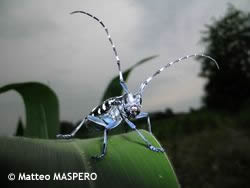
adult
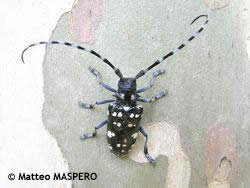
female

male
Past and present situation of Anoplophora chinensis in Lombardia
In 2000, Anoplophora chinensis was first detected in Lombardia in a nursery at Parabiago, 30 km West of Milan, during a survey made for a research project financed by Regione Lombardia on “New exotic pests in Lombardy”. In 2000, the real extent of the A. chinensis infestation was not known yet but it was for sure much larger than the observed initial point of discovery at Parabiago. After several years of monitoring it appears that A. chinensis is present within Milan (mainly in West and North West of the city) and in 30 municipalities North West, West, and South of Milan. The distribution of the pest was determined during an intensive survey program covering the previously known infested sites and their surroundings within a radius of 2 km around any infested tree. The monitoring was based on the visual inspection of susceptible trees to find symptoms of A. chinensis presence. Twelve workers, working in pairs, were hired by the Plant Protection Service through Fondazione Minoprio to monitor the A. chinensis-infested area and the associated buffer zones. From summer 2005, around 60.000 trees were checked in the public areas of more than 60 municipalities.

Surveillance and eradication
In order to detect very quickly the spread of A. chinensis adults and newly infested sites, a specific monitoring procedure was implemented within a buffer zone designed as a ring area surrounding the infested area (extending to 1–2 km beyond the currently known border of the infested zone). Within the uninfested buffer zone, near the border with the infested area, the monitoring system was based on visual inspection of a large set of sentinel plants selected for their great attractiveness to A. chinensis adults. The sentinel trees were marked and positioned on a map, and checked twice a year, at the beginning and at the end of the summer. As soon as new infestations were found, the map of the infested zone was re-designed as well as the buffer zone that contained a new set of sentinel trees.
In order to increase public awareness, since 2001, Regione Lombardia implemented a campaign of information through various media to give the public a better knowledge of the extent of the problem and to trigger appropriate reactions from the people when they found a specimen of the exotic beetle or when they observed signs of A. chinensis presence in plants. Municipalities concerned by the pest problem were part of this education effort. Leaflets and posters on A. chinensis were distributed, meetings with technicians of the municipalities and citizens were organized, press articles were released in newspapers and magazines, radio and TV shows were broadcasted, expert articles were published in scientific journals.
The Phytosanitary Service of Lombardia declared the destruction of the infested trees as mandatory. Plantation of plants species that are among the preferred hosts for A. chinensis was forbidden. Trade and movements of trees and plant species that are potential hosts for the pest were forbidden within the quarantine area. In the municipalities concerned by A. chinensis infestations, treatments of all host-plants with appropriate insecticides was mandatory, and wire mesh sleeve cages were installed in order to capture the adults of A. chinensis that might emerge from the infested trunks and roots. A research project was financed to get a better knowledge of the biology and ecology of the pest, and to test chemical and bio-control techniques.
The Phytosanitary Service of Lombardia works in cooperation with Fondazione Minoprio, the agency for development of the regional agriculture and forests (E.R.S.A.F.) and various other local authorities like the Province of Milan and the sanitary agency. However, all control measures concerning exotic invasive pests are determined and implemented by the inspectors of the Phytosanitary Service of Lombardia. The highest difficulties in pest control efforts are encountered during monitoring and eradication of the infested plants within private properties.
The main host plants of A. chinensis in the Lombardia region belong to the genera Acer, Platanus, Betula, Carpinus, Fagus, Corylus, Lagerstroemia, Malus and Pyrus.
During the eradication phase which consisted of tree cutting and incineration, the periphery of the infested area was treated first. The following table shows the numbers of trees that were destroyed so far.
| Year | No. of plants destroyed |
|
2001 |
25 |
| 2002 | 35 |
| 2003 | 15 |
| 2004 | 168 |
| 2005 | 215 |
| 2006 | 2240 |
| 2007 (till June) | 400 |
The eradication process consisted of:
- cutting down the aerial parts of the infested trees;
- storing them in fenced areas within the municipality territory;
- chipping the whole plant material and burning it to feed a “thermo-valorization system”;
- grinding the infested stumps and main roots using a specific machine.
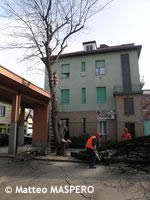
cutting aerial parts
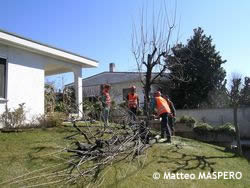
cutting down trees
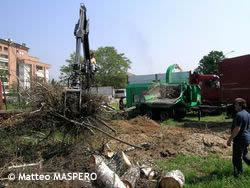
chipping
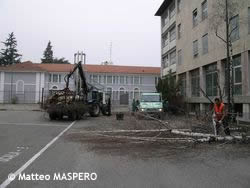
cutting down trees

storage of cut material
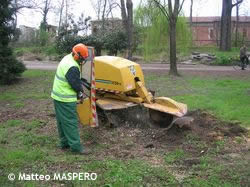
grinding
Because of the continuous evolution of the infestations, each year both monitoring and eradication programs are reviewed by the Phytosanitary Service and adapted to better fit the new pest situation. So far, Regione Lombardia has spent substantial funds to control the pest. One of the challenges for the near future is to get enough additional funds to face the still very important pest problem.
Regulatory framework
The following decrees were published and define the modalities of pest control:
| Decreto Direzione Generale Agricoltura n. 731 del 26 gennaio 2004 | Modalità di controllo ed eradicazione di Anoplophora chinensis in Regione Lombardia |
| Decreto Direzione Generale Agricoltura n. 1898 del 11/02/2005 | Nuove modalità di controllo ed eradicazione di Anoplophora chinensis in regione Lombardia |
| Decreto Direzione Generale Agricoltura n. 11113 del 12/07/2005 | Disposizioni in merito ai trattamenti insetticidi per contrastare la diffusione dell’insetto Anoplophora chinensis forma malasiaca |
| Decreto Direzione Generale Agricoltura n. 9174 del 16-06-2005 | Misure fitosanitarie da adottare nei vivai per contrastare la diffusione dell'insetto Anoplophora chinensis forma malasiaca |
| Decreto Direzione Generale Agricoltura n. 18087 del 05-12-2005 | Disposizioni fitosanitarie per i vivai produttori di piante ornamentali, arboree ed arbustive ricadenti nelle aree dichiarate di quarantena per contrastare la diffusione dell'insetto Anoplophora chinensis forma malasiaca per l’anno 2006 |
| Decreto Direzione Generale Agricoltura n. 5704 del 23-05-2006 | Nuove misure regionali di controllo ed eradicazione di Anoplophora chinensis in regione Lombardia |
| Decreto Direzione Generale Agricoltura n. 6806 del 21-06-2007 | Nuove misure regionali di controllo ed eradicazione di Anoplophora chinensis in regione Lombardia |
| Decreto Direzione Generale Agricoltura n. 7382 del 3-07-2007 | Controllo ed eradicazione di Anoplophora chinensis in Regione Lombardia. Individuazione delle aree di quarantena, focolaio e fascia di sicurezza |
Research project
In January 2005, Fondazione Minoprio sent a proposal to Regione Lombardia to request some financial support to conduct a research project designed to better understand the pest biology, ecology, and behaviour, and to test various control techniques. The 2-year project named “BETOTAC” (Biology, Ethology and Control Techniques of Anoplophora chinensis – approval n° 20734 of February 16th, 2005, on the Regional Official Bulletin) was designed as a cooperative effort between Fondazione Minoprio, the Istituto di Entomologia agraria, Università degli Studi di Milano, and the European Biological Control Laboratory, Montpellier, France.
One of the objectives was to study the development cycle of A. chinensis in Italy, and to compare it with the one observed in its native area. This information was needed to set up a detailed control strategy against the various stages of the pest. The Pesticide Trial Centre of Fondazione Minoprio tested various chemicals to evaluate the efficacy of several active substances against A. chinensis. These studies were carried out in public properties within the A. chinensis-infested area, and in a plastic greenhouse which was built in a fenced property located in the quarantine area. Potted plants of Acer saccharinum were placed in the greenhouse to serve as oviposition sites to pairs of A. chinensis which were released on them.

studies in public areas
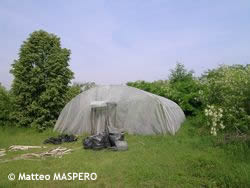
studies under a plastic greenhouse
Biological and ethological studies
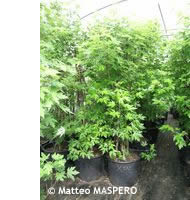 In the public area, 100 infested trees belonging to various species were selected. The A. chinensis adult exit holes from the previous years were counted on these trees, as well as the piles of sawdust from the ongoing larval generation; their position on each tree was recorded.
In the public area, 100 infested trees belonging to various species were selected. The A. chinensis adult exit holes from the previous years were counted on these trees, as well as the piles of sawdust from the ongoing larval generation; their position on each tree was recorded.- In the greenhouse, 20 potted Acer saccharinum were caged individually using sleeves of wire mesh and 20 pairs of adults were placed in each cage. The adult condition and the number and position of the new eggs laid were recorded during the whole life of the adults. Evolution of the symptoms of A. chinensis attacks was checked regularly.
In the Lombardia Region, it appears that the peak of emergence of A. chinensis occurred in late June. Exit holes were mainly located on the roots that are visible on the ground, and at the base of trunks up to 20 cm above ground level.
In the greenhouse, the average longevity of A. chinensis adults was 55 days. Most eggs were laid in late July – early August. The oviposition scars were mainly located around the collar of trees; their density decreased upward on the base of trunks within 50 cm above ground. The maximum height on trunks where eggs were laid increased with egg density.
In Northern Italy, it is suspected that most A. chinensis individuals need 2 years to complete their development cycle, when a small proportion of them only needs one year. However, as this result was based on the observation of a very small number of individuals (26), more repetitions are needed to confirm this trend. Larvae overwinter at various stages, depending on the date of egg laying. Larvae resume intense feeding during spring. The individuals which overwintered as full-grown larvae pupate during spring and emerge as adults in late May-early June. At the end of the pupal stage, the adults stay inside the pupal chamber for a week during which their exoskeleton hardens. The adult chew a perfectly circular exit hole to emerge from its host tree.
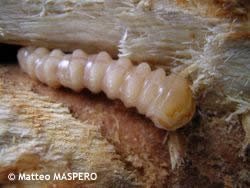
fully-grown larva

adult exit holes

adult exit holes
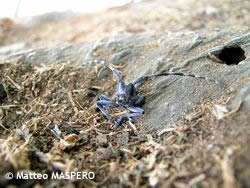
emerging adult chewing its exit hole
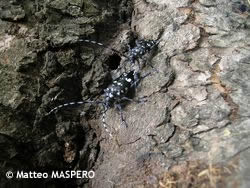
mating
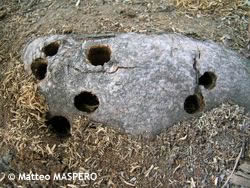
adult exit holes
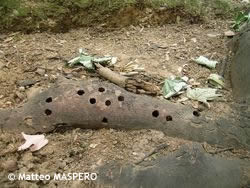
adult exit holes
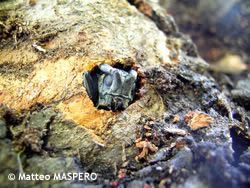
emerging adult chewing its exit hole

maturation feeding
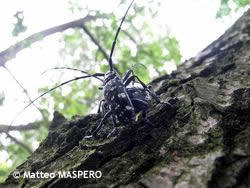
mating
The newly emerged adults move upward on the trunk and start feeding on suckers and the tender bark of young shoots. During and following their maturation feeding, adults mate repeatedly.
Fertilized females move to the base of a tree, around the collar or on main roots, to search appropriate places to lay eggs. With its mandibles, the A. chinensis female begins making a small incision, 3-4 mm long, through the bark, transversally to the axis of the trunk or of the root. When an appropriate place has been found, the female inserts its ovipositor in the prepared incision and injects an egg perpendicularly to the incision, within the bark (more or less at one half of its thickness). Under the pressure of the ovipositor inserted within the bark, the upper layer of bark cracks so that the visible final symptom of an egg laid is a reverse T-shape crack of the bark.
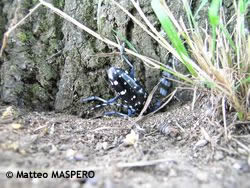
searching for a suitable oviposition site
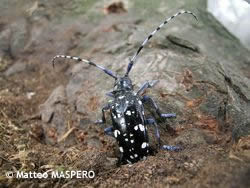
oviposition
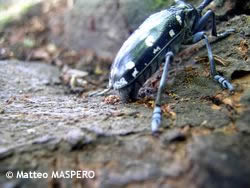
oviposition
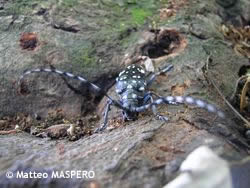
making an incision

oviposition
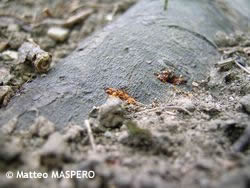
T-shape crack
A single egg is deposited in each incision. At the intersection of the arms of the T-shape crack, one can see a tiny ovoid hole made during the insertion of the ovipositor. This hole is plugged with some brown secretion from the female’s abdomen. This fluid hardens on contact of air, making a stopper that closes the entrance of the egg chamber.
Incubation lasts 15-20 days depending on the temperature. The first instar larva is around 6 mm length; it chews the bark around the egg chamber and enlarges it. The second instar larva bores a gallery to the cambium layer and feeds on the latter. The third instar larva bores a gallery within the phloem and in the external layer of the xylem. In some host-plants (often in Platanus sp.) some sap can ooze from the A. chinensis gallery. A. chinensis full-grown larvae are 50-60 mm length. Through the A. chinensis exit holes and the larval galleries, diseases (mainly fungi) and other insects may produce secondary infections or infestations, thus increasing stress of the host-plant. Adult feeding on young shoots and small branches results in their death.
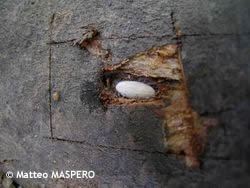
egg
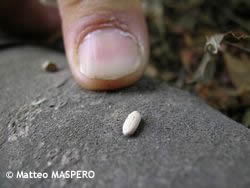
egg
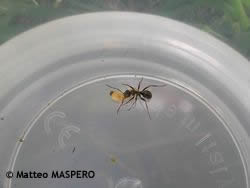
young larva (with an ant)
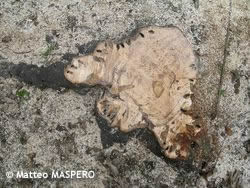
galleries in the phloem and external layer of xylem
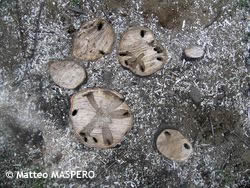
secondary infections
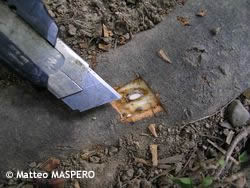
egg
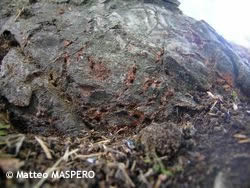
ovoid hole
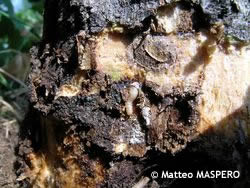
young larva
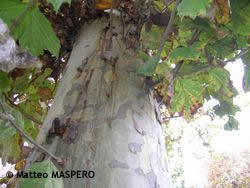
sap oozing on Platanus
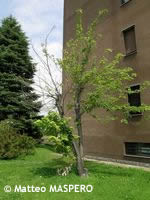
tree death
Chemical tests
Both in public and private properties, many historical trees of high value were found attacked by A. chinensis. To avoid cutting these high value trees, the control of the pest using insecticides was tested. The protection of the high value trees may be one of the major stumbling blocks in the A. chinensis eradication program. The multiple measures taken during the initial step of the eradication program, including the use of selected insecticides, were aiming to prevent the spread of the pest out of the currently infested area, and to slow down its movements within this area.
Two types of insecticide tests were made:
(1) systemic insecticides sprayed on host plants,
(2) systemic insecticides injected into plants.
- Systemic insecticides Thiacloprid 480 g/l (Calypso®), Spinosad 480 g/l (Laser®), Thiamethoxam 25 % (Actara 25 WG®) were sprayed at the bottom of the trunks of infested trees to kill adults when they emerge. The effect of these applications on larvae in their galleries was also checked. Observations were made on 2 sets of trees: (a) infested trees (Platanus x acerifolia) aligned along streets; (b) potted Acer saccharinum in a greenhouse.
- The base of the trunk of infested trees (Platanus x acerifolia) located within the quarantine area was sprayed to contaminate the bark that adults chew when they leave the pupal chamber and bore an exit hole. This treatment had no effect on the emerging adults which survived. The beetle does not consume the wood and bark resulting from the exit hole boring; the sawdust is thrown out of the exit hole. These insecticides had no effect on larval survival either; however, additional tests are needed to clearly determine the real impact of these chemicals on the pest.
- In a greenhouse, the trunk bases of potted Acer saccharinum were sprayed with systemic insecticides and couples of A. chinensis, were released. A small number of oviposition scars was observed and larval activity, evidenced by some sawdust thrown out from larval galleries, was observed during the whole summer. The low level of infestation due to Actara® 25 WG (Thiamethoxam 25 %) showed that this product could prevent only partially new attacks by A. chinensis.
- Endotherapy (injection of insecticides into infested trees) to kill A. chinensis adults when they feed on the bark of suckers and young shoots was also tested. In the laboratory, suckers and young shoots collected on trees that had been treated with systemic insecticides were used to feed A. chinensis adults. Some mortality was observed among the adults that were fed with the contaminated plant material but the experiment was not conclusive because of the small number of adults tested. More tests are needed.
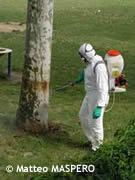
spraying
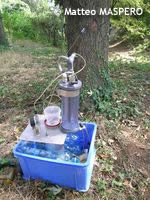
endotherapy
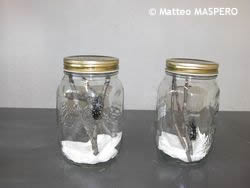
A. chinensis feeding on treated young shoots
Biological control studies
In conjunction with the eradication programs, biological control studies were initiated in order to find, to identify, and to evaluate the parasitoids that could successfully control the pest. With the official agreements (“Letters of Authorization”) from the French and the Italian Plant Protection Services, exposure of early stages of the host in sentinel plants placed in sites within or outside the area infested with A. chinensis in Italy, was made. It showed that some natural enemies, pre-existing in the selected habitats, were attracted by the exotic pest and attacked it successfully. The egg parasitoid Aprostocetus anoplophorae Delvare (very likely originating from the Far East) was identified as a host specific species. The ectoparasitoids, Spathius erythrocephalus Wesmael (Hym.: Braconidae), Eurytoma melanoneura Walker (Hym.: Eurytomidae), Calosota vernalis Curtis (Hym.: Eupelmidae), Cleonymus brevis Boucek (Hym.: Pteromalidae, Cleonyminae), Trigonoderus princeps (Westwood) (Hym.: Pteromalidae, Pteromalinae), and Sclerodermus sp. (Hym.: Bethylidae) attacked early larvae of A. chinensis and developed successfully in this host. Life history traits and behaviour of some of the major parasitoids are currently studied at EBCL, USDA, ARS, Montpellier, France, to evaluate them as potential biological control agents.
References
Caremi, G., M. Ciampitti, and M. Maspero. – 2005. The plan of control and eradication of Anoplophora chinensis form malasiaca in Lombardia region Italy. EPPO meeting, Falmouth, U.K., 5-7 Oct. 2005 (Poster).
Caremi, G., and M Ciampitti. – 2006. il Coleottero Anoplophora chinensis in Lombardia: diffusione e strategie di controllo. ATTI of the Giornate Fitopatologiche 2006, Vol. I: 205 -210.
Cocquempot, C., F. Hérard, and P. Reynaud. – 2003. Les longicornes asiatiques Anoplophora glabripennis et Anoplophora chinensis, une menace sérieuse pour l'arboriculture fruitière, les plantes d'ornement et les forêts françaises. Phytoma. 561 : 24-28.
Cocquempot, C., and F. Hérard. – 2003. Les Anoplophora, un danger pour la pépinière et les espaces verts. PHM-revue horticole, Juillet-Août, 449 : 28-33.
Colombo, M., and L. Limonta. – 2001. Anoplophora malasiaca Thomson (Coleoptera Cerambycidae Lamiinae Lamiini) in Europe. Bollettino di Zoologia agraria e di Bachicoltura, Serie II, 33, 65-68.
Delvare, G., M.-C. Bon, F. Hérard, C. Cocquempot, M. Maspero, and M. Colombo. - 2004. Description of Aprostocetus anoplophorae sp. n. (Hymenoptera, Eulophidae), a new egg parasitoid and a candidate for the biological control of the invasive pest Anoplophora chinensis (Förster) (Coleoptera, Cerambycidae). Ann. Soc. Entomol. Fr. (n.s.) 40 (3-4): 227-233.
Hérard, F., C. Cocquempot, J. Lopez, J. Covi, M. Maspero and M. Colombo. – 2005. Field study to evaluate the egg parasitoid Aprostocetus anoplophorae sp. n. (Hymenoptera: Eulophidae) on two Anoplophora hosts. In: Proceedings, XV U.S. Department of Agriculture interagency research forum on gypsy moth and other invasive species 2004; 2004 January 13-16; Annapolis, MD, Gen. Tech. Rep. NE-332, USDA-FS, Newtown Square, PA. Gottschalk KW [ed]. pp. 40-42.
Hérard, F., C. Jollivet, and P. Reynaud. - 2005. Gestion des foyers de capricornes asiatiques en France, Autriche, Allemagne et Italie : l’éradication est lancée. Phytoma – La défense des végétaux, Juin 2005 – (583) : 22-26.
Hérard, F., H. Krehan, U. Benker, C. Boegel, R. Schrage, E. Chauvat, M. Ciampitti, M. Maspero, and P. Bialooki. - 2005 Anoplophora in Europe : Infestations and management responses. In: Proceedings, XVIth U.S. Department of Agriculture Interagency Research Forum on Gypsy Moth and Other Invasive Species 2005; 2005 January 18-21; Annapolis, MD. Gen. Tech. Rep. NE-337, USDA-FS, Newtown Square, PA.. Gottschalk KW [ed]. pp.35-40.
Hérard, F., M.-C. Bon, M. Maspero, C. Cocquempot, and J. Lopez. - 2005. Survey and evaluation of potential natural enemies of Anoplophora glabripennis and A. chinensis. In: Proceedings, XVIth U.S. Department of Agriculture Interagency Research Forum on Gypsy Moth and Other Invasive Species 2005; 2005 January 18-21; Annapolis, MD. Gen. Tech. Rep. NE-337, USDA-FS, Newtown Square, PA. Gottschalk KW [ed]. p.34.
Hérard, F., M. Ciampitti, M. Maspero, C. Cocquempot, G. Delvare, J. Lopez, and M. Colombo. - 2005. Survey and evaluation of potential natural enemies of Anoplophora glabripennis and A. chinensis (Col. Cerambycidae) in Italy. EPPO meeting, Falmouth, U.K. Oct 5-7, 2005 (Poster).
Hérard, F., M. Ciampitti, M. Maspero, C. Cocquempot, G. Delvare, J. Lopez, and M. Colombo. - 2005. Survey and evaluation of potential natural enemies of Anoplophora glabripennis and A. chinensis (Col. Cerambycidae) in Italy. In Proceedings Seventh International Conference on Pests in Agriculture, Montpellier, France, Oct. 26-27, 2005, p. 56; and AFPP Cd-Rom Acariens-CIRA: 2-905550-02-3, 8pp.
Hérard, F., M. Ciampitti, M. Maspero, H. Krehan, U. Benker, C. Boegel, R. Schrage, L. Bouhot-Delduc, and P. Bialooki. - 2006. Anoplophora spp. in Europe: Infestations and management process. EPPO Bulletin, 36 (3): 470-474.
Hérard, F., M. Ciampitti, M. Maspero, C. Cocquempot, G. Delvare, J. Lopez, and M. Colombo. - 2006. New associations between the Asian pests Anoplophora spp. and local parasitoids, in Italy (2005). In: Proceedings, XVIIth U.S. Department of Agriculture Interagency Research Forum on Gypsy Moth and Other Invasive Species 2006; 2006 January 10-13; Annapolis, MD. Gen. Tech. Rep. NE-USDA-FS, Newtown Square, PA, Gottschalk, KW [ed.] (in press).
Jucker, C., M. Colombo, M. Maspero, M. Valentini, F. Hérard, J. Lopez, C. Cocquempot, G. Delvare, G. Cavalieri, and G. D’Angelo. 2006 - Biological notes on Anoplophora chinensis and control techniques in Italy - Supplementary Abstract book "VIIIth European congress of Entomology, Izmir, Turkey, 17-22 September 2006".
Lingafelter, S.W., and E.R. Hoebeke. – 2002. Revision of Anoplophora. Entomological Society of Washington, 1-236.
Maspero, M., E. Gervasini, M. Colombo, and L. Limonta. – 2002, Present situation of Anoplophora malasiaca spreading in Italy U.S. Department of Agriculture interagency research forum on gypsy moth and other invasive species. Jan. 13-16, 2004, Annapolis, MD. Gen. Tech. Rep. NE-273, USDA-FS, Newtown Square, PA. Fosbroke, S. L. C., Gottschalk, K. W. [ed.].
Maspero, M., C. Jucker, M. Colombo, M. Ciampitti, B. Cavagna, and G. Caremi. – 2005. “The longhorn beetle Anoplophora chinensis (form malasiaca), a new pest of woody ornamentals in Italy”. Introduction and Spread of Invasive Species. 9-11 June, 2005 Berlin, Germany. Humboldt University.
Maspero, M., C. Jucker, M. Valentini, F. Hérard, J. Lopez, C. Cocquempot, G. Delvare, G. Cavalieri, R. Panariello, G. D’Angelo and M. Colombo. – 2006. Note biologiche di Anoplophora chinensis in Lombardia e suo contenimento. ATTI of the Giornate Fitopatologiche 2006, Vol. I: 197-204.
Prepared for EPPO by:
Matteo Maspero, Guglielmo Cavalieri, Giovanni D’Angelo - Fondazione Minoprio, V.le Raimondi 54, 22070 Vertemate con Minoprio, Como, Italy.
Costanza Jucker, Marta Valentini, Mario Colombo – Istituto di Entomologia agraria, Università degli Studi di Milano, Via Celoria 2, 20133 Milan, Italy.
Franck Hérard, Jaime Lopez, Nathalie Ramualde - European Biological Control Laboratory (EBCL), USDA-ARS, Campus International de Baillarguet, CS90013 Montferrier-sur-Lez, 34988 Saint Gély du Fesc Cedex, France.
Mariangela Ciampitti, Gualtiero Caremi, Beniamino Cavagna – Servizio Fitosanitario Regione Lombardia, Via Pola 12/14, 20124 Milano, Italy.
This note was published thanks to the Research Project grant “BETOTAC” entitled “Biology, Ethology and Control Techniques of Anoplophora chinensis” (Regional Official Bulletin - approval n° 20734 of February 16th, 2005), funded by the D.G. Agricoltura of Regione Lombardia.

Many thanks to all of those who have contributed
to the eradication programme against A. chinensis
